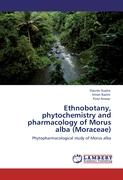- Start
- Ethnobotany, phytochemistry and pharmacology of Morus alba (Moraceae)
Ethnobotany, phytochemistry and pharmacology of Morus alba (Moraceae)
Angebote / Angebote:
Mulberry, Morus alba L., as a non-toxic natural therapeutic agent, belongs to the family of Moraceae, and has been cultivated in many Asian countries such as China, India, Korea, Japan and Thailand where the leaves were used as food for silkworms. It is a natural food additive having carbohydrates, lipids, proteins, fibres, sugars, vitamins, mineral etc. in appropriate proportion. It is a potent food antioxidant commonly used as a dietary supplement. Researchers suggested that it can be used as a good pharmaceutical food. It has been used since ancient times in folk medicine for its many medicinal properties. The plant has been used in Indian tradition as a nervine tonic. This widely grown plant has been in use by tribals of this country for ailments such as asthma, cough, bronchitis, edema, insomnia, wound healing, diabetes, influenza, eye infections and nose bleeds. The plant extract has been demonstrated to posses free radical scavenging activity. It has been extensively studied for its antidiabetic, antibacterial, antianaphylactic, neuroprotective, hypolipidemic, hypotensive, antiatherosclerotic, anticancer, antidepressant effects.
Folgt in ca. 10 Arbeitstagen

